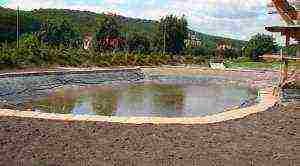Content [show]
At present, the deterioration of the ecological situation and frequent poisoning by forest mushrooms have led to a surge in the popularity of cultivated mushrooms. Oyster mushrooms and mushrooms, unpretentious in care, flooded the market and slightly pressed the meat on the tables. Several years ago, exotic shiitake mushrooms appeared in our latitudes - they came to us from the Far East, where they have been successfully grown on an industrial scale for a long time.
Statistically, shiitake is the most cultivated edible mushroom in the world. It tastes like champignons and porcini mushrooms. High nutritional value, pleasant taste, as well as the discovered healing properties of shiitake determine its popularity in the cuisines of different nations of the world. In Japan and China, these mushrooms have been traditionally grown for two millennia on the fallen trunks and stumps of shii trees (an analogue of our oak) and other deciduous trees. With the development of cultivation technology on sterile sawdust, it became possible to grow shiitake at home.
Shiitake cultivation methods
Shiitake mushrooms are saprotrophs that grow in natural conditions on dying wood, under the conditions of cultivation they resemble oyster mushrooms. A distinctive feature in comparison with other cultivated mushrooms is a rather long maturation of the shiitake mycelium, low competitiveness in comparison with colonies of bacteria and mold. Experienced shiitak breeders argue that, subject to sterile planting conditions, as well as growing technology, it is quite easy to obtain the fruiting bodies of mushrooms.
There are two main methods of growing shiitake:
- extensive - the natural growth of the fungus on wood is copied on specially prepared cuttings of the trunks, which are forcibly infested with mycelium. This method is suitable for regions with a humid climate. The greatest period of fruiting occurs in the second year of the development of wood raw materials by mushrooms. More than two-thirds of the world's shiitake production is grown using this technology;
- intensive - the basis for the growth of mushrooms are chips and sawdust of deciduous trees, as well as cereal straw. To increase the nutritional value of the subtrate, grain, bran, hay, mineral additives (chalk or gypsum) are added to it. The substrate is carefully sterilized or pasteurized - and the seed mycelium is added to it, which colonizes the blocks and after a while begins to bear fruit.
Intensive cultivation of shiitake
Intensive (industrial) cultivation of shiitake is carried out on substrates consisting of 60-90% of hardwood sawdust with a diameter of 2-3 mm. For this purpose, sawdust of oak, maple, beech, birch and other hardwoods are suitable. In addition, the substrate may include wood chips (it increases the friability of its structure), as well as dry and clean straw of cereals, crushed to a size of 1-2 cm, and hay.
To accelerate the colonization of mycelium and improve fruiting, grain, bran, legume flour, tea leaves and beer waste, as well as chalk or gypsum to optimize acidity, are used as nutritional supplements. The resulting mixture is moistened with clean water, bringing the substrate moisture level to 60-65%.
It is important to note that too small a diameter of sawdust impedes the gas exchange of the substrate, an overabundance of nutrients creates an environment favorable for the development of microorganisms that compete with shiitake, which often displace fungi. Therefore, for the optimal development of fungal mycelium, preliminary sterilization or pasteurization of the substrate is required, packed in plastic or polypropylene bags with a volume of 1-6 liters with special biofilters for gas exchange. After heat treatment and cooling, the substrate mixture is inoculated (inoculated) with mushroom mycelium, which in a warm place gradually colonizes the substrate, turning it into a dense block - within about 1.5-2.5 months. Next, the mushroom blocks are removed from the film or container - and placed for fruiting in a cool room with high humidity.
How to grow shiitake mushrooms
The method of growing mushrooms on wood scraps is more labor intensive. It is suitable for humid Asian climates, as opposed to local continental ones. The extensive method of mushroom cultivation is more costly than the intensive method. Planting mycelium is easier to organize on substrates composed of sawdust, wood chips and straw. Such a nutritious subtrate can be stocked up without much material costs. The most suitable is dry clean straw of oats or barley, golden brown, with no visible signs of decay. To grow shiitake at home, you will need a room in which you can maintain a regime of a certain temperature and humidity, intense lighting. You also need to prepare bags of dense polyethylene or agryl (non-woven material for covering the beds). Experienced mushroom growers recommend packing mushroom blocks of about 2.5 kg. The first shiitake harvest can be obtained in 60-70 days.
Preparing mushroom blocks
Before sowing mushroom mycelium, it is necessary to sterilize or pasteurize the substrate in order to destroy various microorganisms in it, which otherwise may multiply and become a serious competitor to shiitake mushrooms. For sterilization, you will need a barrel into which the straw is tamped tightly, poured with boiling water. The barrel is placed over the fire - for heating for several hours, after which the straw is laid out in a clean container and left to cool, and then packed into bags, shifting layers of the substrate and mycelium (at the rate of 2-7% of the shiitake mycelium from the mass of the substrate), trying distribute the mushroom material evenly.
The seed mycelium is made of two types:
- sawdust - it is grown on a sawdust-bran mixture, it is specially adapted to the appropriate substrate. The sowing rate of such a mushroom mycelium is 5-7%;
- grain - is a placer of grain overgrown with mycelium, which is at the same time a nutrient medium. The seeding rate of this mycelium is 2%.
If you have not purchased special bags with porous filters along with the mycelium, then in ordinary plastic bags it is necessary to make side holes with a diameter of several centimeters through which gas exchange of mushroom blocks will be carried out. After filling with the substrate with mycelium, the bags must be closed on top with a cotton plug or sealed (in the case of bags with micron filters). The blocks prepared in this way are placed in the room at a height of at least 20 cm from the floor, since the sprouting mycelium actively emits carbon dioxide, which goes down.
Forcing the fruiting bodies of mushrooms
During the incubation period in the room, it is necessary to maintain the temperature regime within 25 ° C - this temperature is considered optimal for the germination of mycelium. At temperatures above 28-30 ° C, there is a possibility of damage to the substrate by competitive microorganisms (mainly trichoderma and neurospore - green and orange mold). A change in the color of the substrate block to white will indicate the germination of the mycelium, while nodules and swellings of various shapes will begin to appear. The brown color of the block indicates the beginning of ripening and early fruiting of the mushrooms.
The mushroom blocks are removed from the bags and placed in cold water for two days, and then returned back. Two weeks after such a procedure, shiitake fruiting bodies usually appear, which will grow to full-fledged mushrooms for another half a month. To start fruiting shiitake, high humidity (80-95%) and poor ventilation are required to maintain high levels of carbon dioxide. For the period of mushroom picking, the humidity is lowered to 50-70%. Shiitake bears fruit in waves; on one mushroom block, two or three harvests of fruit can be expected.
Shiitake mushrooms - photo
How to grow shiitake mushrooms - video
Shiitake mushroom (aka shiitake) comes from eastern countries, the Chinese and Japanese value it no less than the healing ginseng root, due to its high content of nutrients.
The cultivation of shiitake mushrooms in artificial conditions began precisely in those regions, gradually the technology "migrated" to us, the mushroom is cultivated both for amateur and commercial purposes. Shiitake is not capricious and, subject to certain conditions, gives good yields; it is one of the most aromatic, tasty and rich in composition mushrooms.
About shiitake
In the wild, the shiitake mushroom actively grows in the foothills of Japan, Korea, and China. He does not like lowlands, excessive heat and frost. It is practically not found in Europe and hot countries, and in Russia it can be found only in some regions of Siberia and the Far East.
Shiitake belongs to the group of saprophytes, that is, it feeds on the organic matter of the wood on which it grows. Gradually, the stumps with myceliums are destroyed.
Outwardly, it is an ordinary medium-sized hat mushroom. The diameters of the caps vary from 5 to 20 cm in diameter, the legs of the fruit are thin. The hat has a patterned color similar to a turtle's shell and ranges from cream to dark brown.
The mushroom is fleshy, very aromatic, contains a large amount of trace elements and vitamins.
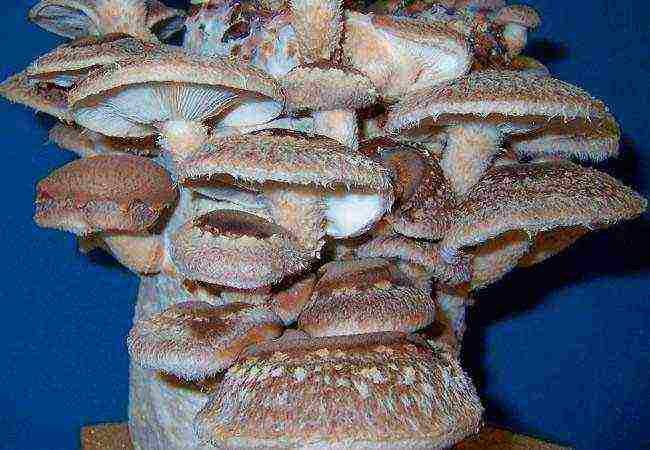 Shiitake mushroom (shiitake)
Shiitake mushroom (shiitake)
Growing shiitake mushrooms at home gives good results, the mushroom is unpretentious if placed in the right environment.
Due to the fact that Shiitake prefers high-mountainous regions, sea air and a temperate climate, in our area it is very difficult to grow it in nature (in gardens, in plots). For artificial reproduction, you will have to allocate a separate room: a basement, a shed, a hangar, in which special conditions will need to be created. Some people manage to grow shiitake right in the apartment, on the balcony.
Technology for growing shiitake mushrooms at home
The most optimal way to grow shiitake mushrooms in artificial conditions is to use bags and a substrate. The blocks are placed in a prepared room and the conditions for fruit propagation are observed.
Room preparation
To breed shiitake indoors, it is necessary to create good ventilation, lighting of at least 100 lux and an air temperature control system. Mushrooms love warmth during the day and cool at night. The optimum daytime temperature for them is + 15-18 ºC, at night - + 10 ºC. During the sowing period and until fruiting, the temperature is raised to +25 ºC. Air humidity is maintained within 70-80%. A drip irrigation system is recommended for irrigation.
The room must be clean, completely disinfected; for the convenience of placing myceliums, it is better to use racks with shelves.
Shiitake mycelium
Since the mushroom grows only in a certain region of our country, it is not possible to collect its mycelium on your own in the wild. The easiest way to buy seed is from a shop or Shiitake commercial plant.
The seller is obliged to indicate on the packaging the date of harvesting the mycelium, the shelf life and the conditions necessary for the content of the material.
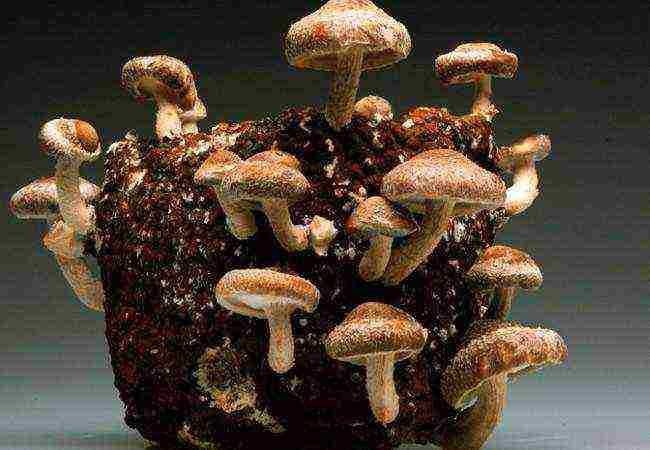 Shiitake mushroom cultivation technology
Shiitake mushroom cultivation technology
Substrate preparation
For the substrate, you can use tree sawdust mixed with dry leaves, hay, sunflower husks.
The material must be sterilized to destroy all harmful microorganisms. To do this, the mixture is placed in water and boiled for about two hours, then cooled and wrung out.
Packages also need to be processed. The easiest way is to rinse them in a chlorine solution. The substrate is laid out in bags raw, alternating layers with mycelium (each block should account for no more than 8% of mycelium). The edge of the bag is tied with a rope.
Then the mushroom blocks are laid out on shelves at a short distance from each other. Each bag is cut with a clean, sterilized knife or blade (up to 20 holes per block).
All work should be carried out with gloves and in the most sterile conditions so that harmful microbes do not get into the mycelium.
Incubation period
The cultivation of shiitake mushrooms largely depends on the correct observance of the conditions for incubation, which lasts an average of about three weeks. All this time, the temperature in the room is maintained at no higher than +25 ºC and humidity is about 80%. The room is not ventilated or illuminated at this time.
As soon as the first fruits appear, the air temperature should be lowered to +18 ºC during the day and even lower at night. They begin to ventilate the room, irrigate the mushrooms every day and maintain a humidity of about 70%. Also, mushrooms need light daily, for at least 5-6 hours.
Shiitake harvest on mushroom block
Mushrooms actively bear fruit for a month. The fruits are harvested in the usual way - by cutting off the legs. After the first harvest, the blocks continue to be taken care of, in 30-40 days a second wave of harvest can be expected.
Each mycelium can bear fruit for 5-7 years. But periodically they need to be given rest, plunging into "hibernation". To do this, the temperature in the room is reduced, active watering is stopped. After a month, care is resumed and a new harvest is expected.
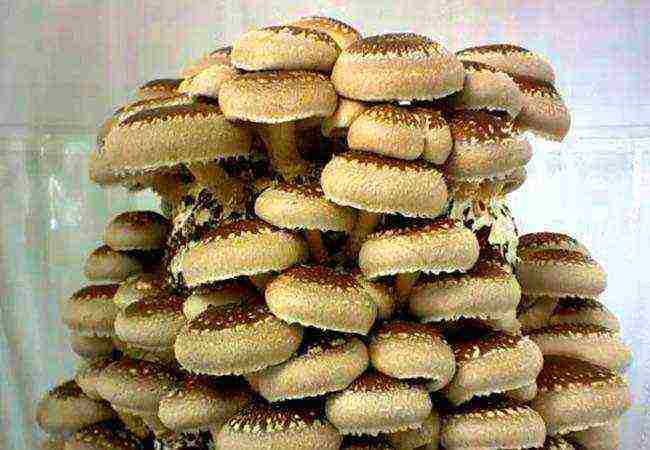 Shiitake harvest on mushroom block
Shiitake harvest on mushroom block
Growing shiitake mushrooms at home in the country
You can try growing shiitake outdoors in your yard. This will require stumps or bars. If there are no stumps in your area, then find blocks of coniferous or deciduous trees and dig them into the ground.
Planting is best done in May, then in the fall there is a chance to get the first harvest. Stumps 2-3 weeks before planting the mushrooms must be moistened, but not much, pouring water over them. At the time of seedling, the moisture content of the wood should be about 50%.
Depressions are made in the wood with a drill or hacksaw. Shiitake mycelium is placed in the holes. From above, the stump is thrown with wet sawdust. Stumps (bars) should be kept moist, but not more than 40%. When the mycelium begins to bear fruit, they need to be watered more often.
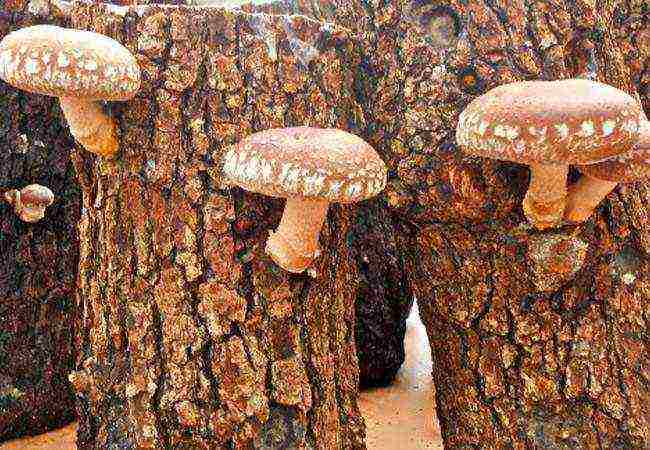 Growing shiitake mushrooms at home in the country
Growing shiitake mushrooms at home in the country
Such myceliums can take root only in those regions where there are short, not too frosty winters and mild summers. In the remaining areas, greenhouses will need to be created for the bars.
Now you know that growing shiitake mushrooms is not so difficult, unlike, for example, breeding boletus or truffles. Shiitake does not create a symbiosis with trees, and has a "docile" character, so its cultivation is gaining more and more popularity. In addition, it is also a very tasty, juicy mushroom from which amazing dishes are obtained.
Since ancient times, mushrooms in Russia have been a serious help in the economy, bags of dried and barrels with salted forest gifts were exported to Europe by sea and land, this trade was very profitable and brought considerable income. To date, scientists have found that many types of mushrooms have not only excellent taste and nutritional qualities, but also have a healing effect in many dangerous diseases, ranging from common colds and ending with malignant neoplasms.
Unfortunately, today in the forest there is no longer such an amount of harvest and species diversity that our grandparents found - the deterioration of the ecological state of the planet as a whole had an extremely negative effect on the condition of all forest inhabitants. However, do not despair, some types of mushrooms can be grown in the garden. We have already talked about growing oyster mushrooms and champignons in previous articles: “Growing oyster mushrooms. Additional income on your site "and" Technology for growing mushrooms. Small business in the country ". Today I would like to touch upon the issue of artificial cultivation of shiitake and honeydew.
In our time, the issue of growing organic food is quite acute. In pursuit of profit, many manufacturers stuff vegetables and fruits, meat and dairy products with various preservatives and stabilizers to improve taste and increase shelf life. Such "delicacies" in many cases cause allergies and other dangerous diseases. Growing mushrooms in the country will help you replenish your family's diet with an environmentally friendly food product that contains a sufficient amount of protein, various useful vitamins and microelements that are indispensable for the body.
Shiitake cultivation
Shiitake is rightfully considered the patriarch among the artificially grown mushrooms. This species has been cultivated for more than 2000 years in the countries of Southeast Asia. Already at that time, the healers of oriental medicine said that shiitake gives a person vigor and energy, protects against stroke and other cardiovascular diseases. In the 14th century, the Chinese physician Wu Rui drew attention to its effectiveness in the treatment of malignant neoplasms.
Modern research fully confirms the healing properties of shiitake, and in Asia this mushroom is called "mushroom ginseng". Japanese and Chinese scientists are confident that the healing properties of shiitake far exceed the power of various medicinal herbs.
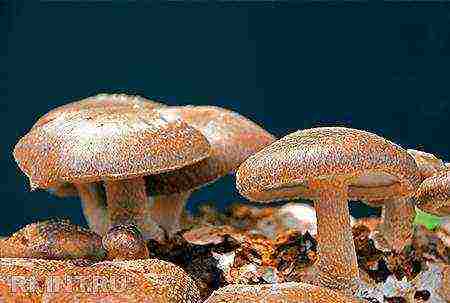
In nature, shiitake grows on dead wood of broad-leaved trees such as oak, beech, chestnut, hornbeam. The distribution area of this mushroom covers Japan, China, the Far East and other countries of Southeast Asia. The mushroom has a pleasant aroma, and its taste is not inferior to champignon.
In terms of production of shiitake, it ranks second in the world after champignon, and today the number of farms for growing this type of mushroom is steadily growing. Japan is considered the leader in shiitake production, followed by China and Korea. However, these exotic mushrooms are grown today not only in the East, farms engaged in the cultivation of this species are located in Australia, Italy, Germany, and the USA. Small shiitake plantations can be found in mushroom farms in Belarus, Russia and Ukraine.
Nowadays, Shiitake is grown according to intensive and extensive technologies. However, intensive cultivation requires compliance with extremely stringent sterile conditions, since this type of fungus is very susceptible to various diseases.
Intensive technology
To prepare the substrate, in this case, sawdust and bark of deciduous trees are used, to which bran and various nutrient mixtures are mixed. Sometimes straw is used.The crushed, moistened, well-mixed substrate is placed in special polyethylene or polypropylene bags of small capacity, which can withstand high temperatures (up to 135 degrees). After that, they are subjected to thorough sterilization for several hours in autoclaves with increased steam pressure.
Inoculation (seeding of mycelium) also requires sterile conditions. For this, special boxes and laminar flow cabinets are used. After infection with shiitake spores, the bags are placed in specially prepared rooms, where the microclimate necessary for incubation and fruiting is observed, the necessary sterility is also maintained here, for which special filters for ventilation and other devices are used.
The intensive technology of cultivating shiitake allows you to grow mushrooms all year round, however, given all the above difficulties (availability of special equipment, maintaining the necessary sterile conditions), this method is unlikely to be suitable for use on a personal plot. In the country, it is better to use extensive cultivation methods.
Extensive technology
At present, 2/3 of all mushroom farms that cultivate this species work using extensive technology.
For growing shiitake, hard-leaved tree species such as oak, hornbeam, beech, chestnut are suitable. You can also use alder, maple, birch, aspen, willow and poplar. The specificity of the fungus is that, on the one hand, it does not live on a living tree, and on the other hand, it does not grow with a low water content. Therefore, logs for cultivation are harvested in early spring or late autumn, since it is during this period that the wood contains the most moisture. In addition, at this time, the bark is firmly attached to the wood, which reduces the risk of infection by harmful fungi and microorganisms.
For extensive cultivation, it is necessary to harvest trunks with a diameter of 10–20 cm, with a thin bark through which light can penetrate. For the normal development and fruiting of shiitake, lighting is required; in the dark, fruiting bodies either do not appear, or mushrooms with thin long legs grow. The trees must be healthy and free from rot. Trunks with differently colored spots and stripes cannot be used for shiitake cultivation.
Wood is harvested in the period after leaf fall and before the start of sap flow. The cut trees are left in the forest for 1-2 months, after which they are transported to the site of the future plantation. Here they are cut into pieces 1–1.5 meters long.
How to infect wood with shiitake spores
Trunks can be inoculated in two ways. The first is to use sterilized wedges infected with mycelium with a diameter of 1.5–2 centimeters. The wedges are driven into holes drilled in the logs.
Most often, mycelium grown on sawdust is used for inoculation. In the logs, cuts are made to half their diameter, or 15–20 holes are drilled 2 centimeters in diameter and 5 centimeters deep. Contaminated sawdust is introduced here, and the outside of the holes is covered with wax, resin, or sealed with adhesive tape. The consumption of mycelium in this case is 1 kg per 1 cubic meter of wood.
After infection, the logs are placed in a clean, wind-protected place. The laying of the prepared bars should be carried out without contact with the ground in order to avoid the penetration of pathogens into the mycelium.
The logs are laid in a shaded place, covered with polyethylene on top, this will help to preserve the necessary moisture. In dry hot weather, additional watering will be required. The most suitable temperature during mycelium growth is 24-28 degrees. With fluctuations in the smaller and larger sides, the growth of the mycelium slows down, and at temperatures above 35 degrees, the shiitake spores may die.
The duration of the overgrowing of logs depends on the density and moisture content of the wood and on the ambient conditions (temperature and humidity). Experience shows that mycelium develops faster on soft wood. The period for the development of logs by mycelium is on average 6–18 months. The wood is considered mature if it does not ring on impact, and if there are white zones of mycelium on the cross sections.
Fruiting shiitake
In autumn, when the average daily temperature is set at 12–20 degrees, the infected logs are placed in shaded areas, either vertically digging into the soil, or stacked in the shape of the letter "X", maintaining a lean-to configuration.
Under natural conditions, the formation of fruiting bodies is stimulated by rains. But in order not to depend on the mercy of nature, in order to accelerate fruiting, the logs mastered by mycelium are either soaked in water for 2-3 days, or irrigated as needed.
The first mushrooms begin to appear at a temperature of 12-18 degrees, at first one can notice single fruiting bodies, then they begin to grow already in groups of 25-30 pieces on one log.
Shiitake bears fruit in spring and autumn. The spring harvest tends to be larger, but in the fall the mushrooms are of better quality. The duration of cultivation of this mushroom on infected logs is 3–6 years, the yield of mushrooms is 15–20% of the wood mass.
With the onset of cold weather, the plantation is well covered with spruce branches or straw mats. Shelters are removed in spring, when the air temperature reaches an average of 8-10 degrees.
Cultivation of honey agarics
In addition to oyster mushrooms, champignons and shiitake, some gardeners successfully grow different types of honey agarics on their backyards. In nature, there are several edible varieties of this mushroom - summer honey, winter, autumn and meadow honey. With some effort, all these mushrooms can be grown in summer cottages and vegetable gardens. The cultivation methods in this case will differ depending on what type of seed you have available, as well as on different temperature regimes (as the names themselves say - summer, autumn, winter).
Growing honey agarics on wood waste
Experts call this method intensive, since honey fungus develops and bears fruit on a substrate prepared from wood materials much faster than on stumps or tree sections.
The substrate can be various wood waste of coniferous or deciduous species - sawdust, wood chips, shavings. As a rule, a nutrient medium for cultivation is prepared from a mixture of waste, for example, two parts of sawdust, one part of shavings and one part of chips are taken. It is important to note that before preparing the substrate, wood waste must be well dried. During drying, many competing fungi die, and the wood receives the moisture capacity necessary for cultivation.
The substrate is prepared as follows. Based on one liter of water, add 15 grams of any jam and 15 grams of oatmeal or corn flour (can be replaced with starch). The water is boiled for 20–30 minutes, and upon evaporation, it is added to its original volume.
Wood waste is placed in three-liter or five-liter jars and poured with the prepared boiling solution, tightly closed with lids and kept for 8-10 hours. The consumption rate for a three-liter bottle will be 1.5 liters of solution, for a five-liter bottle - 3 liters.
After that, the jars are opened and the unabsorbed water is drained through a gauze filter. When the water is already released in drops, you can start adding the mycelium. For these purposes, mycelium must be purchased from people who are professionally engaged in breeding honey agaric. Wild forest mycelium is not suitable for the intensive method.
Before sowing, shake out half of the substrate from the bottle into a clean dish. Then scatter over the remaining half of the mycelium and mix thoroughly right inside the jar.The other half is mixed with the mycelium in a bowl, and then poured back into the bottle. The consumption of mycelium in this case will be as follows: 50 grams must be poured onto a 3-liter jar, 100 grams on a 5-liter jar.
After sowing, the bottle is closed with a polyethylene lid, in which a 1.5 by 2 cm window is made. This hole is closed with foam rubber so that no gaps are formed anywhere. The prepared jars are placed in a room with high air humidity and a temperature of 22-24 degrees. Light at the moment of overgrowth is not needed.
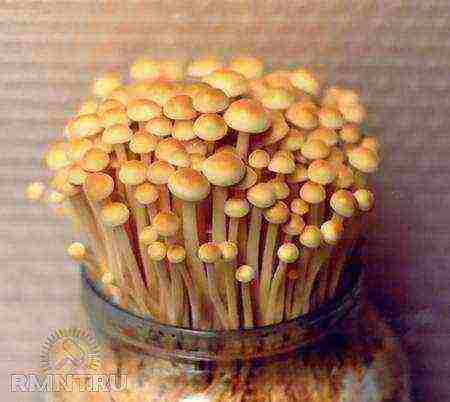
The rudiments of fruiting bodies begin to appear in 1.5–2 months, the lids from the cans must be removed at this very time. It is important to ventilate the room well, as an excess of carbon dioxide can lead to underdevelopment of honey agarics. After the end of fruiting, the substrate for re-cultivation can no longer be used. He is taken out to the garden, where he will act as a wonderful organic fertilizer. Wood waste substrate can also be used as mulch. This will increase fertility and improve soil structure in your area. We talked in more detail about mulching in an article from the cycle of organic farming "Let's Make the Earth Good".
Growing honey agarics on stumps
Summer, autumn and winter honey fungus can be grown on stumps. Areas with stumps from aspen, birch, pine or spruce are suitable. It is important to note that the state of the stumps before laying the mycelium must correspond to some necessary parameters.
The stumps should not be infected with tinder fungi, the wood should be dense enough. The moisture content of the stumps in this case plays an important role, since the mycelium will not germinate with a lack of moisture. This indicator is determined by sight (by dark color) and by touch. You can increase the moisture by watering the stumps one to two days before sowing.
For growing honey agarics on stumps, sowing material can be found in the forest. These will be the fruiting bodies of the honey fungus or parts of the wood affected by the mycelium. If you opted for fruit bodies, then the sowing technique will be as follows. It is necessary to select overripe caps with a diameter of 8-12 centimeters. A bucket of water will need 20–25 of them. We soak the caps in water (preferably rain or from a river) and leave for a day. After that, knead the contents of the bucket with your hands until a mushy mass is formed, mix everything well and filter through cheesecloth. It is with such a filtered solution that the ends of the stumps are watered. For better penetration from different sides, depressions and cuts can be made, into which the mass remaining after filtration is placed, and then thoroughly watered with the resulting talker from the spores. On one stump with a diameter of 20 cm, pour from 0.5 to 1 liter of solution. The grooves and ends of the stumps after the mycelium are introduced are well covered with sawdust to maintain the required moisture. With this method, the spores germinate slowly, and the honey mushroom harvest is obtained, as a rule, after 2 years.
You can get a harvest faster (after a year) if you infect the stumps with pieces of wood with an already overgrown mycelium. They are found in the forest in places of abundant growth of honey agaric and chipped off with a special tool - you can use a chisel or work carefully with an ax.
In the prepared stumps, depressions of the required size are made, where the infected wood is tightly hammered. From above, all this must be well covered with sawdust. Honey mushrooms bear fruit at a time when it happens in nature, that is, in summer, autumn and, under suitable conditions, in winter. It all depends on the species. In severe frosts, to avoid freezing, the stumps are densely covered with coniferous branches. On plantations with summer honeydew, branches are harvested at the beginning of June, and with autumn and winter - at the end of July.
As you can see, there is nothing particularly complicated in the extensive technology of growing shiitake and honey mushrooms.Having the desire and making some effort, you can provide your family with an ecologically pure valuable food product, which is especially important today. Or you can earn a little extra money, because the demand for mushrooms is constantly growing today.

Today, in terms of the global production of shiitake mushrooms, it is in second place of honor, yielding only to the usual champignons. Unfortunately, in Russia this species has not yet become as widespread as in other civilized countries. Nevertheless, armed with the desire and simple instructions from this article, every vegetable grower can independently master the cultivation of shiitake mushrooms.
Preparing a substrate for sowing mycelium
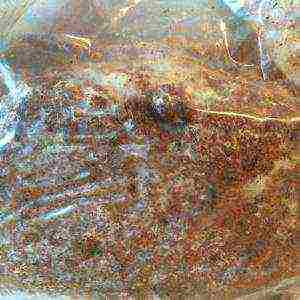 For the cultivation of shiitake, it is better not to use whole pieces of wood like hemp or wood blocks, but finely chopped wood substrate. Thus, the mushroom mycelium will receive a sufficient amount of oxygen and develop faster.
For the cultivation of shiitake, it is better not to use whole pieces of wood like hemp or wood blocks, but finely chopped wood substrate. Thus, the mushroom mycelium will receive a sufficient amount of oxygen and develop faster.
The nutrient medium is prepared from chips cut with a garden grinder or freshly prepared twigs with a diameter of no more than four centimeters. For this, wood of the following species is suitable: willow, oak, alder, apple, birch, aspen, yellow acacia, pear and many other deciduous trees. However, the ideal option is still oak sawdust or shavings. In this case, the size of individual grains should be from two millimeters to two centimeters.
It is better to put the prepared substrate into action right away, but you can also dry it in a Russian oven or in the oven and send it for storage.
For every 1.5 kilograms of dry wood and 2.2 kilograms of freshly cut branches, it is useful to add 100 grams of barley grain and 10 grams of chalk. Barley can also be replaced with wheat grain or barley.
Wood waste is placed in a three-liter jar, slightly compacting each layer. As soon as two to four centimeters remain to the neck of the jar, boiling water is poured into it (for the purpose of disinfection). After a couple of hours, the water is drained, and the cans with wood are kept at room temperature for another 24 hours.
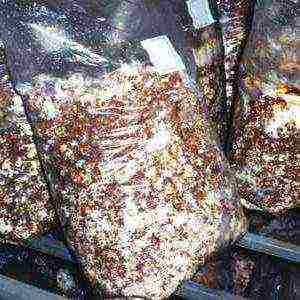 During this period, fresh spores of bacteria and molds appear in the wood pulp, the destruction of which should be perfectly handled by the last heat treatment. To do this, the remnants of the liquid accumulated in it during the day are drained from the jar, cover its neck with several layers of gauze and put it in the oven, heated to 80-110 degrees, for 2.5-3 hours.
During this period, fresh spores of bacteria and molds appear in the wood pulp, the destruction of which should be perfectly handled by the last heat treatment. To do this, the remnants of the liquid accumulated in it during the day are drained from the jar, cover its neck with several layers of gauze and put it in the oven, heated to 80-110 degrees, for 2.5-3 hours.
As soon as the jar has cooled, the upper chips are slightly moistened with boiled water at normal temperature (from 1 to 1.5 teaspoons). Then on the surface of the wood with a spoon disinfected with boiling water spread 20-25 grams of grain or 40-50 grams of shiitake substrate mycelium. The mycelium is slightly pressed into the substrate with the same spoon.
A lid with a hole 1 cm in diameter is placed on the jar (the hole is closed with a piece of sterile medical plaster). After 7 days, the plaster is torn off, and a piece of sterile cotton wool rolled into a roll is stuck into the hole. If you do not perform the last action, then mushroom mosquitoes can climb into the jar and spoil its contents.
Incubation and distillation of mushrooms
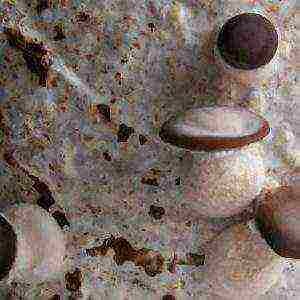 In this form, the substrate should stand in a warm place for two months. It is convenient to control the development of the mycelium through the glass of the jar. The completion of incubation is evidenced by the growth of the mycelium over the entire internal volume of the jar, as well as the clarification of the substrate itself (small brownish specks may also appear on it).
In this form, the substrate should stand in a warm place for two months. It is convenient to control the development of the mycelium through the glass of the jar. The completion of incubation is evidenced by the growth of the mycelium over the entire internal volume of the jar, as well as the clarification of the substrate itself (small brownish specks may also appear on it).
Ripe mycelium is transferred into plastic bags measuring 20 by 35 centimeters, or 25 by 40 centimeters. The bags are tightly closed (by twisting them in the upper part) and again put away in the heat.
After a week, the top of the bag is unpacked and a piece of an old hose with a diameter of 2.5-3 centimeters and a length of 4-5 centimeters is placed in it. Through this opening, fresh air will constantly flow to the substrate.Just remember to cover the hole with a sterile cotton plug again to prevent pests from reaching the substrate. Keep in mind that the overgrowth is more active if the bags with the mycelium are in an upright position, with the cotton stopper up.
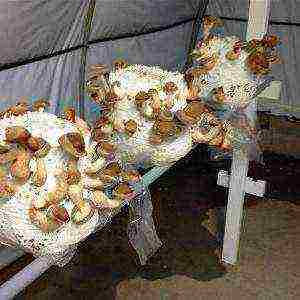 Over the next two weeks in the warmth, the wood chips grow together into a single monolith and are strongly compacted. By this time, the piece of substrate is usually covered with growths of mycelium, in appearance, resembling popcorn grains. Immediately after this, the development of the fruit bodies themselves begins in the form of hard black beans (the so-called primordia). Then it is necessary to move the blocks to a place suitable for fruiting. d
Over the next two weeks in the warmth, the wood chips grow together into a single monolith and are strongly compacted. By this time, the piece of substrate is usually covered with growths of mycelium, in appearance, resembling popcorn grains. Immediately after this, the development of the fruit bodies themselves begins in the form of hard black beans (the so-called primordia). Then it is necessary to move the blocks to a place suitable for fruiting. d
If, after three weeks, dark bumps have not appeared on the blocks, you can stimulate their formation with the help of cold shock. This is done as follows: the substrate in bags is transferred to a cold (from 0 to +10 degrees) room for a period of at least three days. Then the blocks are pulled out of polyethylene, put in heat (at a temperature of +15 to +25 degrees) and a piece of film is thrown on top. A day later, another film is removed, and the substrate is transferred to a place prepared for fruiting.
Make sure the blocks do not show signs of incipient mold such as blue or dirty green spots.
Where and how best to grow shiitake
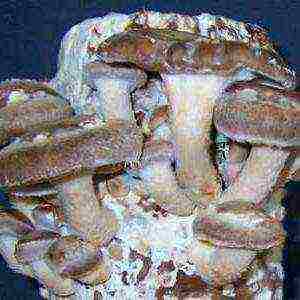 For the best fruiting of shiitake, it is necessary to ensure the following conditions: ambient temperature - + 15 ... 18 degrees, relative humidity - from 80 to 90%, the duration of daylight hours - at least 10 hours. It is also desirable that the area designated for growing mushrooms be protected from the winds of all directions and the southern sun. Thus, mushrooms will feel best in the shade of garden buildings or under the canopy of a garden shed.
For the best fruiting of shiitake, it is necessary to ensure the following conditions: ambient temperature - + 15 ... 18 degrees, relative humidity - from 80 to 90%, the duration of daylight hours - at least 10 hours. It is also desirable that the area designated for growing mushrooms be protected from the winds of all directions and the southern sun. Thus, mushrooms will feel best in the shade of garden buildings or under the canopy of a garden shed.
A shade-tolerant spot is also a good place for shiitake.
A more plentiful harvest of mushrooms will provide you with shiitake cultivation under a specially equipped shed. Such a canopy is usually placed under the crown of garden trees. To give the structure stability, install a frame from an old greenhouse in the garden. Make one side from agrofibre or any other non-woven material, and make the other three from usually film. Place pieces of slate, dark film or any other material out of direct sunlight on the greenhouse cover.
Before placing the blocks in the prepared place, remove them from the bags and thoroughly pour cool water from a hose day. In the house, not the blocks themselves are sprayed from the greenhouse, but the film walls.
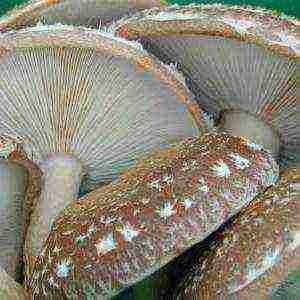 To stimulate the growth of shiitake in an open area, a spacious bag-cap can be thrown over each block of mycelium.
To stimulate the growth of shiitake in an open area, a spacious bag-cap can be thrown over each block of mycelium.
The first harvest of mushrooms ripens in the second or third week after removing the blocks from the bags. In mushrooms, only the caps are cut off, they are carefully turned upside down on the legs.
After that, blocks with intact mycelium crust should be placed in a pool or shallow pond to moisturize. After two to three days, the mushroom blocks are turned over on the other side, and so that they do not unfold in random order, a weight is fixed to their lower part with the help of a clove. In general, it is necessary to saturate the block with moisture so that its final weight is 35-65% more than the initial one (that is, if before the first wave of the harvest the substrate in the bag weighed 1.5 kilograms, then after moistening the weight should already be from 2 to 2, 5 kilograms).
The moistened blocks are returned to their original place and after two to four weeks they begin to bear fruit with renewed vigor. In one mushroom season, you can see from five to six such harvest waves. Mushroom picking ends when the blocks start to fall apart. Such residues can be used to make an excellent fertilizer suitable for all garden plants.
By the way, did you know that shiitake can grow even in water? To do this, the blocks are simply left in a pool, puddle, barrel or in any other body of water on one of the sides down for about a week, until the first rudiments of fruiting bodies are formed. Then they are turned over with their wet side up and after a week and a half, the first caps of young mushrooms appear on its surface, and after a couple of days it will be possible to start harvesting.
Of course, shiitake can also be grown on stumps (although this method is less productive). But if you choose this particular option, then by all means watch the following video.


